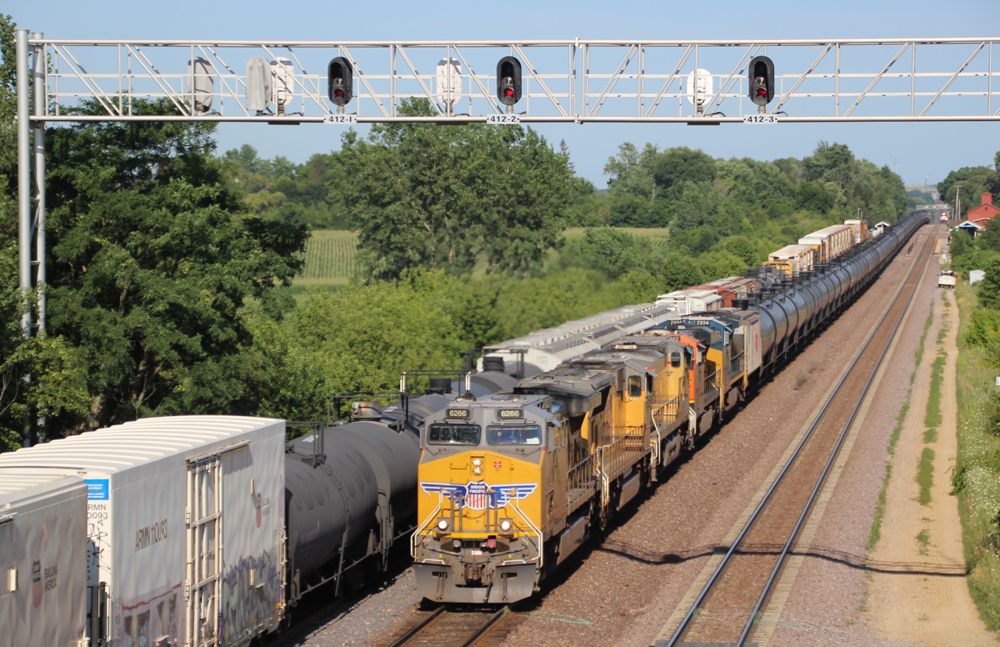
It’s fitting that Union Pacific’s logo is a shield. The beleaguered railroad needs one given the barrage of arrows coming its way.
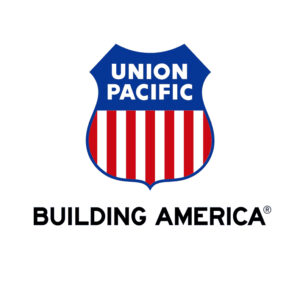 UP has a long list of problems, many of them self-inflicted as a predictable result of its pursuit of a 55% operating ratio. There are so many issues confronting UP that it’s hard to know where to begin.
UP has a long list of problems, many of them self-inflicted as a predictable result of its pursuit of a 55% operating ratio. There are so many issues confronting UP that it’s hard to know where to begin.
Amtrak could have chosen practically any host railroad as the target for its first regulatory complaint over the handling of its passenger trains. But in December it chose UP, whose woeful treatment of the Sunset Limited makes it the long-distance train with the worst on-time performance in the land.
How bad, you ask? Well, Amtrak says that in its worst quarter last year Sunset passengers arrived late more than 90% of the time, with UP bearing responsibility for roughly 75% of the delays the train encountered between New Orleans and Los Angeles.
The primary culprit, Amtrak claims, is UP’s practice of running freights that don’t fit in passing sidings. When the Sunset gets behind a long train that can’t make track speed, there’s nowhere to overtake the no-fitter. And so the Sunset plods along, getting later and later despite a schedule that has more padding than a sumo wrestler.
If Amtrak trains are the canary in the freight railroads’ coal mine, they’re giving plenty of warning about the state of UP’s overall operations and the service it provides.
Yes, like the other three big U.S. railroads, UP has experienced crew shortages, as it’s become harder to hire conductors amid the tightest job market in decades. But CEO Lance Fritz admits UP was already running too lean when crew shortages cropped up. So when harsh winter weather raked the railroad in early 2022, UP coagulated and never fully recovered.
One symptom of UP’s operational morass is its skyrocketing use of embargoes. Last year UP issued more than 1,000 embargoes in response to congestion, compared with just 27 in 2017 — the year before it adopted a Precision Scheduled Railroading operating model.
UP issues the vast majority of congestion-related embargoes, which alarms regulators. The Surface Transportation Board and shippers called UP on the carpet during two days of hearings in December. Congestion, STB Chairman Martin J. Oberman has said, is a euphemism for “we don’t have enough crews to move our trains and keep our network fluid.”
Loop Capital Markets analyst Rick Paterson says UP’s reliance on embargoes shows a flaw in the system, whether it’s the railroad’s level of crews, power, or track capacity. “Something is not right, and it hasn’t been for a while,” he wrote in a note to clients.
Another way Uncle Pete stood out last year: It was the only railroad slapped with an STB emergency service order. In June UP was ordered to prioritize delivery of corn to Foster Farms, a California-based company that’s the largest poultry producer in the west and whose feed supplies were dwindling. UP apparently didn’t learn its lesson. Foster Farms last month asked the STB for another emergency service order, saying that feed was again running critically low because UP service had deteriorated since October.
Still pending at the STB are two cases customers have brought against UP.
Sanimax, a small shipper in the Twin Cities, argues that UP is violating its common carrier obligations by regularly missing switches and unilaterally reducing local service from five days per week to three. The case could set a precedent for the entire industry.
The Omaha Public Power District has filed a rate complaint against UP for a reciprocal switch involving unit coal trains interchanged with BNSF Railway a few miles from the UP-served power plant.
Meanwhile, UP has thumbed its nose at regulators. Its initial service recovery plan filed in May, and its response to the STB’s request for information on embargoes, both fell well short of the board’s expectations. Oberman called UP’s service recovery plan “by far the worst of all Carriers and reflected an attitude of indifference” to service issues and the STB’s oversight.
UP’s inexplicable behavior with the STB baffles independent analyst Anthony B. Hatch. “Why wave the red flag in the bull’s face?” he asks. Indeed.

Safety also is a concern at UP. Its train accident rate was the highest among the big Class I railroads in 2021 and through the first 10 months of 2022, according to a review of Federal Railroad Administration data. UP’s employee injury rates are in line with the other big systems. But four UP employees died in three tragic accidents between August and November last year.
If there’s a common thread woven through UP’s woes, it’s the railroad’s quest to reach a 55% operating ratio. In an attempt to get there, UP has slashed costs while sacrificing service and operational resiliency. The operating ratio is but one of several important outcomes of the way you run a railroad. Starting with an O.R. goal and working backwards distorts the entire business.
So it shouldn’t be a surprise that running an overly lean railroad has backfired. It costs more to run an under-resourced sluggish railroad with a high recrew rate and unpredictable service. Plus, revenue is lost when traffic is diverted to trucks. Customers complain to regulators. And regulators demand answers. UP is caught in a vicious circle, not the virtuous circle railroads need to grow and prosper over the long term.
Paterson puts it this way: “If UP is unable to stabilize service over the next few years, the end game will be more share losses to BNSF, no deceleration in share losses to trucks, more pushback from price-fatigued captive shippers culminating in greater re-regulation risk … and a stock that’s little more than a no-growth buyback and dividend yield play. That’s not Building America and nobody wants that, including presumably UP management.”
It’s time for an about face in Omaha — before it’s too late. UP should follow Norfolk Southern’s lead and drop its focus on the operating ratio while building a railroad that can provide reliable service year in and year out. Until it does, UP’s “Serve, Grow, Win — Together” strategy will continue to be an empty slogan.
You can reach Bill Stephens at bybillstephens@gmail.com and follow him on LinkedIn and Twitter @bybillstephens






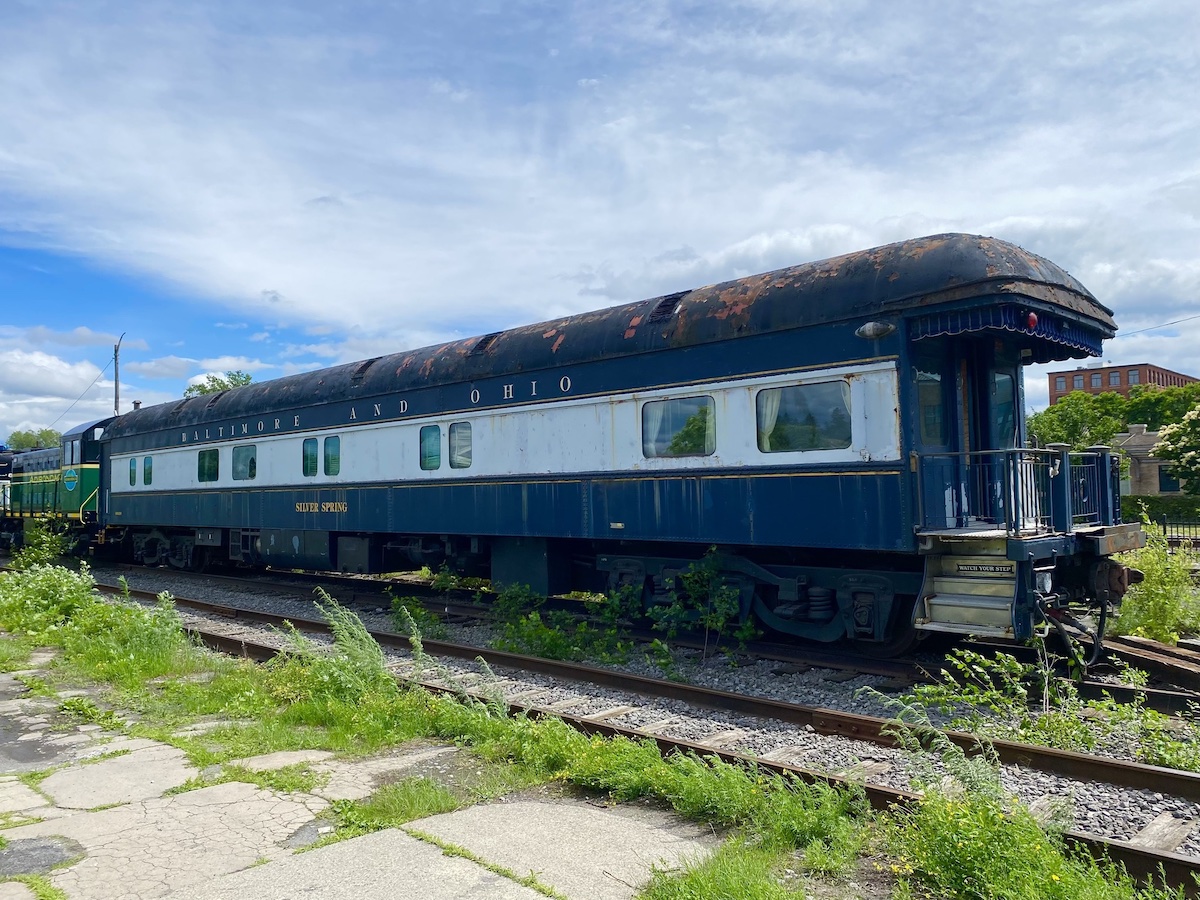
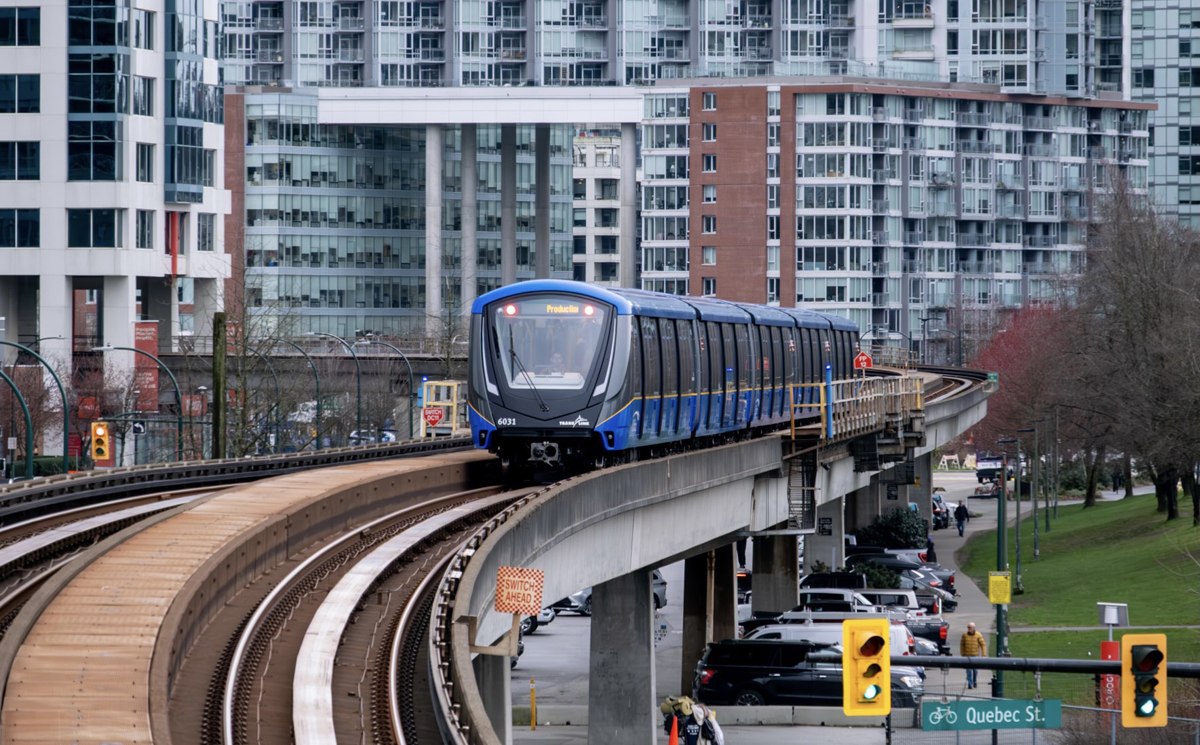
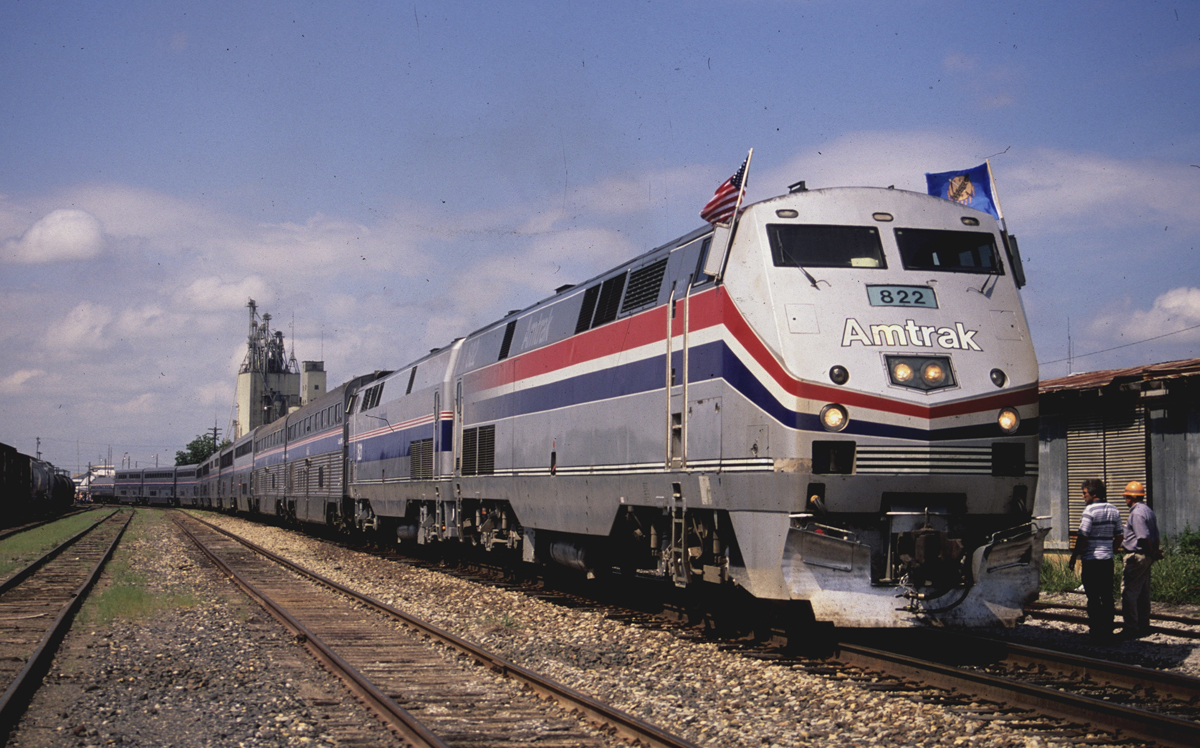
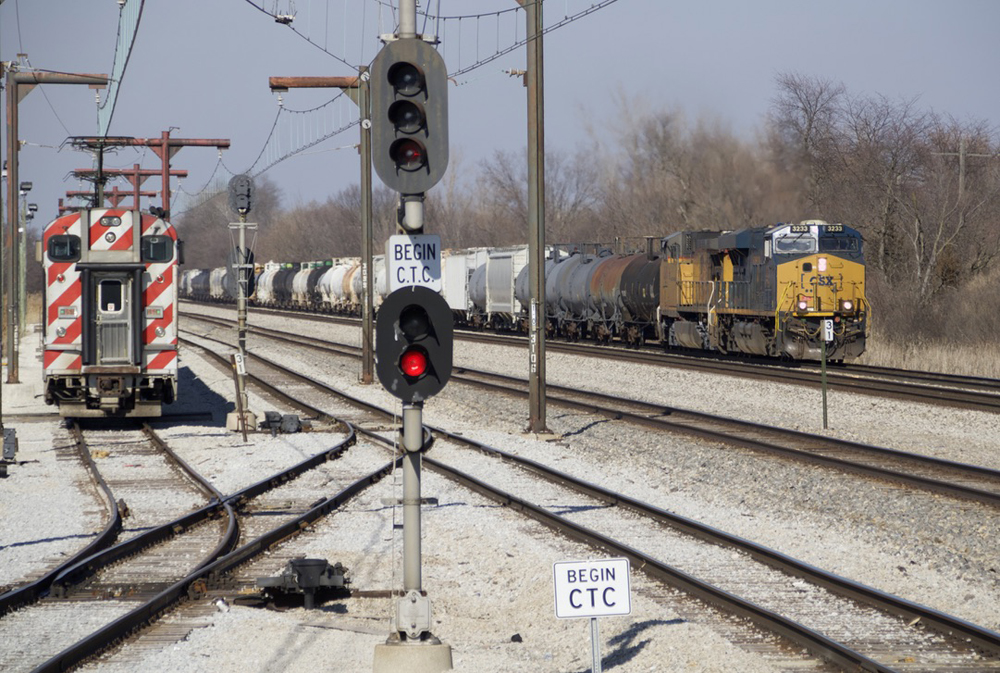




I began my railroad career in early October, 1965, as a telegrapher with the M-K-T in North Texas working a few small agencies on vacation relief but spending most of my time at either Ney Yard in Fort Worth or Dallas Yard.
That was interrupted in Feb., 1966, for a three-year tour with the US Army that saw me assigned to the US Army Alaska near Anchorage which gave me personal exposure to the Alaska RR. The train dispatchers office on the second floor of the depot was my refuge on most weekends and days off and I was given significant exposure to the property since I was on military leave of absence from the M-K-T during the time.
Returning to life as a civilian required no introduction and it was back to the M-K-T where my skills as a telegrapher were no longer necessary. There were still the dispatcher’s wire and the message wire but I really couldn’t telegraph very well at all since the Army had me intercepting Soviet and Warsaw Pact radio traffic in International Morse and the clicking and clacking of Morse landline sounds was now little more than noise to my ears.
As I mentioned in a previous comment to another story, I spent one year (1970-1971) as agent at Waxahachie, Texas, for the M-K-T, the CRI&P, and the FW&D (the latter two operating as the Burlington-Rock Island Joint Texas Division) which generated (in my opinion) significant daily carload traffic, ranging from twelve to sixteen fifty-foot boxes of fiberglass insulation going nationwide, ten to fifteen carloads of glass beer bottles going primarily to Coors Brewing in Golden, Colorado, and, during harvesting season in the early Fall, ten or more forty-foot boxes of baled cotton going to Galveston for export to China (that was special for me since that was the opening of China to US products and getting sufficient mty boxes daily was crucial to putting Ellis County on the map for providing the produce), one tank car of cottonseed oil weekly for mixing with milo and cottonseed hulls going to Fort Worth and Amarillo for cattle feed at Bunge and ADM Mills, two to three forty-foot boxes weekly of cottonseed hulls to Fort Worth and Amarillo, and, finally, five to eight covered hoppers of wheat and milo destined variously to Fort Worth and Amarillo for the feed mills or, sometimes, too Galveston for export.
One year later, In June, 1972, I went to work for SP in Houston as a train order train dispatcher on the east end of the San Antonio Division, handling BSM’s, auto parts trains, merchandise and perishable trains from LA to East St. Louis as well as quite a few other perishable trains also trains of varying importance to no importance at all. And, I handled part of the Sunset Route (CTC) which saw Amtrak trains 1 and 2 so in eight hours, I handled more trains in eight hours than I saw on either the Northern or Southern Divisions of the M-K-T in as twenty-four hour or on the Alaska RR system in the same time span.
More than twenty-four years later, on Sept. 11, 1996, Union Pacific showed up the drive a wooden stake in the heart of SP, to demonstrate how superior their people were in every phase of railroad operations. At that time, I was asst mgr of operating rules for SP and was quickly demoted to go-fer status because I did not have a college degree. I had already been shepherding some UP management types around prior to the day of infamy and their comments were of a pompous and arrogant nature while simultaneous asking questions about certain operating policies and practices SP had in force that had been in existence for many years and were in the same rule book UP subscribed to. I was left puzzled by such questions and therefore the skill levels possessed by these erstwhile operating managers.
In the early Summer of 1997, I was in the Harriman Center while still being based in the soon-to-be vacant SP world headquarters in Denver. I was presumably a train dispatcher rules instructor and had been identified as such to the UP employees when I was approached by a UP corridor manager who wanted me to issue an instruction to train dispatchers that was a clear violation of the “General Code” and “Instructions Governing Train Dispatchers and Control Operators”.
I told this imperious little snipe that I would not issue the requested instructions because of their illegal connotations and he immediately got all huffy and pissy and told me that i was being insubordinate. Now, I finished up my military career as a drill sergeant at North Fort Lewis, Washington, something I’m not really proud of, but I learned far more than I thought I did and periodically fell back into that mindset as a civilian and in the cited case, I became a drill sergeant again.
I got up from my desk char and walked around to where Little Napoleon was standing, putting to those of my shoes again his. I was six feet four inches tall while he was considerably less and I began by asking him “How long have you been working for the railroad, sonny?” He replied “Almost six years” and I responded “I’ve spend more time pissing in railroad ruin all than you’ll ever achieve. Tell you what, sonny. I’m gonna do you a real big favor. You bring me a letter over your payroll signature telling me exactly what you want done and I’ll do it.”
Well, young hero looks up at me and says “I’m gonna report you to my superintendent for being insubordinate!” and turned around and marched away. I heard from his superintendent, who was only a little older than his minion, and more or less told him how the operating rules work and that there are no deviations and no legitimizing deviations. For the first time in my ten-month Union Pacific career, I was told that I was a trouble maker. I would hear that many more times over the next two-point-five years.
During my ten days at the Harriman Center, I observed UP train dispatchers at work and also reviewed written operating instructions and found factual errors of policies and practice. I reported them to the appropriate corridor directors or superintendents who seemed to be inconvenienced with such information. Their home-grown staff of train dispatcher rules instructors did not know of any different or proper way to conduct themselves when on duty as train dispatchers and to do so would’ve inconvenienced any coffee or cigarette time.
Unfortunately, I was in the building when UP experienced a fatal head-on collision between two opposing freight trains at Devine, Texas in June, 1997, and event caused by the error of a young train dispatcher. The crews of both trains were killed and as a component of the settlement, one of the widows demanded that UP install CTC over what was dark territory between San Antonio and Laredo and it was done.
My greatest tale of all as an employee of the great big rolling railroad was when a senior operating officer, Charles Malone, decided in late 1997, to close Strang Yard, about 35 miles south of Houston’s Englewood Yard, so as to cut off thirteen yard engines and their crews. That’s a nice savings except Strang Yard served refineries at Texas City and other locales between Houston and Galveston, generates two solid petrochemical trains daily destined for East St. Louis and Conrail and one train testing to NOLA and the SOU. Of course, it also received three mty trains daily and, coincidentally, took in approximately four-hundred cars from the refineries and businesses and sent out a similar humber for loading or to consignees. But Charles Male was gonna put a feather in his cap and despite the protestations of former very senior SP operating officers now with UP, Strang Yard was closed.
Immediately, Englewood yard began taking in cars that would otherwise have been forwarded to Strang and, conversely, trying to build trains destined for East St. Louis and NOLA that would’ve been built at Strang. Within thirty-six hours, Englewood was tied up like a Gordian know and could not take in trains from NOLA, San Antonio, Galveston, Shreveport, Fort Worth, or North Little Rock. And trains began to tie up in sidings or on line because they could not get into the terminals just named. Thus began the Great Gulf Coast Meltdown of 1998 and for reasons that I was never know, I was one of six or seven former SP operating officers named to a “team” to go to Houston in the first week of January, 1998, and straighten our things and restore fluidity to the railroad.
My task was to create a local train dispatching office that would incorporate three physically separate interlocking towers within the Houston Terminals and to bring in certain BNSF dispatchers from NOC in Fort Worth and KCS dispatchers from S’port to have an office where all essential parties are in the same room and can see and talk to each other on a face-to-face basis. Arranging for a multitude of “things” was monumental, n to the least of which was telephone, radio, and data communication circuits as well as bringing in signal circuits from all over Texas but it was done and the office opened for service on March 5, 1998.
As an aside to the office opening, in late January, 1998, UP solicited bids from train dispatchers in Omaha to fill anticipated vacancies in the new Spring, Texas, office and, while I wasn’t in Omaha, I submitted a bid for the vacancies thinking that would bet me out of Harriman Center. But, as fate would have it, I received a terse letter from thnsenior VP of Harriman Center telling me that I was not qualified to fill any of the anticipated vacancies in the new office. Now, keep that in mind because in the third week of February, 1998, as the opening date of March 5, 1998, was settled upon, I was TOLD by the regional VP in Houston, the same guy who a few weeks earlier who told me I was not qualified to be a train dispatcher in the new office, that I would have to work the territory between Houston and Iowa Jct (east end of Lake Charles) on the first day. because the incumbent of the job would not be available to protect the assignment until March 6, 1998.
And, what about Charles Malone? Well, by mid-1998, he was promoted to VP-Terminals for the UP System. Failure is very much an option and a boon to a career.
From a railfan’s point of view, I can remember UP running up to 100-120 trains a day on the Triple Track main between Gibbon Junction and Bailey Yard from my viewing spot at the Kearney municipal parking lot and all around Kearney, Nebraska back in October 2014. AT the time almost half of the trains were coal trains: half of them were loads east and empties west. When I retired on 2017, I noticed a bit of a drop but still it was fun to come out and vacation along side the Transcontinental mail line. The last 2 visits in 2021 and 2022 showed quite a reduction. Due to climate change, a lot of coal trains wee abolished. And then I remember talking to someone at the Golden Spike Tower in North Platte and how investors were basically running the railroad into the ground. And then seeinng these gargantuan double freights, especially the doubled up coal trains: 270 cars and an estimated 40,000 ton consist. I do not know how the engineers put up with the pressure to keep these almost 3 mile long behemoths running. UP, get folks back to work, please give them the needed sick time that they so deserve, and, oh, i don’t know, tell your stockholders to stop being so greedy. Put people to work and treat them with overdue respect. Put trains back to the old lengths. You’ve strip the bones. And there’s only so much marrow available.
PSR, PTC, remote control switchers…massive trains that don’t fit…well thats all part of PSR. It is the ‘Whats New’ mind think. As in, if the guy has a really nice suit and sells you the talk then it must be REAL….well, he is selling it to the shareholders and the speech is getting stale. This is what you get when it is run the way it is run. Throw out PSR, go BACK to running short fast trains, treat the people like human beings and things will happen. MOVE THE FREIGHT.
It’s crap like this that got me out of being a rail shareholder.
Here’s a “modest proposal” to improve safety, a ruling by the STB that fines an originating railroad $1,000 per car for any train whose length exceeds any siding on its route, multiplied by the number of short sidings. These “heck with service” roads need a financial incentive to force change. Another might be to require double pay for all re-crew personnel. And bonus pay for travel time for both the old and new crew members. They need a kick, not just angry words.
As Eli Goldratt, the Just in Time logistics scholar once said when referring to implementation issues regarding same, “You either change the PEOPLE, or you CHANGE the people.” Change the mentality of Change those leading it. At UP it is time to CHANGE THE PEOPLE. Current management (CEO) has got to go. Surely there is a John Kenefick or Mark Davis somewhere in that organization!
There is nothing wrong with the Union Pacific that a change of management would cure.
I’m reminded during the UP-SP merger meltdown, UP blamed everyone except themselves for the disaster. I wonder to what degree UP’s failings over the past two decades are due to a complete inability to admit they’ve done wrong and reflect.
I’m sure current UP management has plenty of excuses as to why this chaos isn’t their fault.
When PC was at it’s worst, I was there seeing it, I was watching the struggles, and I thought, “How is this going to ever be fixed?”, but along came CR, and it eventually was. So hope is still alive, but wow, the management seems to be hypnotized by the OR angel/devil too badly to see it. Now they have all kinds of enemies, can’t get employees, and they keep on messing up. I wonder what UP’s “Conrail” will be called, if it gets that far. Maybe breaking up UP into chunks and giving parts of it to BNSF, NS, and CSX will fix things. Make all 3 of them transcons, and do the job! One of my friends is very happy he didn’t take the job years ago with UP when he was offered it, he would be probably cashing out about now. When your mom leaves you some bucks, it makes choices easy, like “I’m not gonna take it anymore!”, and walking away. I guess it’s going to be interesting over the next couple of years.
It’s interesting that you draw a parallel between PC in the early 1970’s, which was hemorhhaging red ink for reasons well beyond its own control, and today’s ultra-profitable Union Pacific, which got into this sad situation all by itself. But it does not disprove the point that both railroads are in crisis, only under different circumstances.
Railroads fought hard against regulation in PC days, but deregulation has run its course since.
Maybe operating a railroad à-la-Southwest-style is not what is needed.
UP’s latest move is to point the middle finger at the STB, FRA, American Citizens, BLET, and UTU as they institute a “one man crew” pilot program. The FRA recently announced they will not allow the Class 1’s to institute or bargain with unions for “one man Crew’s” because there’s not enough data to guarantee safety. UP obviously didn’t like this and are afraid two man legislation is coming so they’ve decided they’re going to run a pilot program with one man Crew’s and after the pilot program is over, they’ll analyze the data. Now, does anyone believe the data won’t show favorable and biased results towards going to one man Crew’s ??? It’s like having a drug addict run the methadone clinic: “absolutely no med’s missing here”. The FRA needs to slap UP down, along with all these arrogant CEO’s running these Class 1’s, and let them know whose in charge of “safety”, because the ONLY thing these CEO’s care about is creating ever higher profits for Wall Street investors, at all costs. Poor customer service, higher fee’s, blocked crossings all across America, and poor and unsafe working conditions for employees are the norm now thanks to these CEO’s and their “race to the bottom”. If these RR’s get “one man crews” anytime soon, you’ll truly see how much worse it can get out here for everyone, customers, employees, and American citizens.
I struggle now when railroads say “the weather caused it”. The NWS can now predict with 70-80% accuracy the weather as far out as 10 days. In the 1990’s I still remember Chicago Mayor Daley II declaring a weather emergency 4 days before the snow hit. That was 30+ years ago.
So doesn’t UP keep an active weather map in their operations center? You mean to say they don’t look at the NWS forecasts and work their priority consists appropriately?
They should be able to know with 10 days warning that certain hotshots should be sent through the alternate routes. That staffing and ops support needs to be adjusted accordingly.
This isn’t a transportation company. This is a “we’ll get to it when we feel like it” company. They deserve the heat they are getting, every degree of it.
Paging Mr. Bezos: Your railroad is ready for purchase.
Ladies and Gentlemen:
Behold, the Bill Stephens Mic Drop.
There is but one solution to the sad state of Class I railroads:
Total nationalization.
That’s not the solution.. Railroads need some form of economic protection from investors..
Has Marijuana been legalized in Nebraska? What the h$ll are they smoking at 1400 Douglas Street (UP headquarters) in Omaha these days?
On a more serious note, very good, informative, and insightful article, Bill Stephens. I’ve really enjoyed your many recent, well-written, and informative columns lately. Keep up the great work!!
Not sure I can add anything insightful or unique to the extensive comments already posted here except to say as a Union Pacific stockholder, I look forward to the next (2022) Annual Report later this spring and making my concerns known via the proxies (and voting against Lance Fritz and the UP Board of Directors, who are running a once industry-leader railroad into the ground …).
Where is the 21st century’s EH Harriman? He is no doubt spinning in his grave right now …..
“UP should follow Norfolk Southern’s lead and drop its focus on the operating ratio while building a railroad that can provide reliable service year in and year out. Until it does, UP’s “Serve, Grow, Win — Together” strategy will continue to be an empty slogan.”
This is what exactly needs to happen. Focus needs to be shifted to running the railroad. If that is done correctly, THE PROFITS WILL TAKE CARE OF THEMSELVES. UNFORTUNATELY, Mr Fritz and his buddies don;t seem to be grasping this concept. I believe the stockholders need to take control of their railroad and pronounce, “OFF WITH THEIR HEADS…”
It’s pretty evident that UP management has adapted the “we know what we’re doing because we have MBA’s and are smarter than everyone else.”
Hah! Just keep telling yourselves that. In the name of efficiencies and profits, cut to the point of inefficiency and ultimately, failure. Then blame everything and everybody else. Then, what do the Wall Streeters do? Shrug, move on from the wreckage to the next unsuspecting slob corporation, like a locust swarm.
Not only has UP’s senior management lost its way operationally, but the company evidently remains an awful workplace. It doesn’t appear Mr. Fritz and his lieutenants have done much to improve employee morale in HQ or in the field since Glassdoor in Dec. 2020 ranked UP as the worst company in America to work for. To grow and prosper, the railroad industry needs to attract and retain young, talented individuals. The UP board needs to start making changes.
There are no consequences or penalties for class 1s. Or for that matter any large corporation. Penalties for Southwest Airlines, not! Mayo Pete is asleep at the switch or perhaps diaper duty.
We have regulatory capture and state capture by corporations. They can throw millions towards lawyers, lobbyists and campaign contributions.
Hopeless…
i just can’t tell what can be done to get the railroads to end psr ?
As a Uprr conductor with 18+ yrs of service I can’t disagree with anything with article and bill’s spot on with whats wrong with Uncle Pete. Until Lance gets his golden parachute and leaves we will continue down this path of running the Once mighty UP Right into the Ditch. We haven’t had a Real CEO since Jim Young passed away. We had the right man in Cameron Scott but PSR and it’s safety last Operating model walked him right out the door into early retirement. FYI He’s now president of OMNITRAX.
Why should Lance get a golden parachute? Start a new trend. FIRE him with no severance, no stock options etc.
Another one bites the dust- A once great railroad who played an important part and role in the growth and development of this nation and especially opening the West to development and settlement is now a former shell of itself and is now a stooge of the Wall Street interests and capos. This is what happens when you let your company be controlled by Wall Street. Its not a railroad anymore or even a company you want to work for or build your future in. Just another puppet and cash cow for Wall Street and its minions. Customer relations, good will the labor force and good feelings don’t matter anymore. Only profits and money to stuff into the coffers of greedy investors who couldn’t even tell you what the railroad does or its purpose or the proud history and tradition that was once known as the Union Pacific Railroad. Congrats to Wall Street- you did it again and will keep doing it to American industry and transportation You brought the Union Pacific down along with other great companies. Perhaps the Union Pacific shield should be changed to a dollar sign with a human hand dipping into a pocket What a shame
Joseph C. Markfe;der
UP has been here before – before Harriman took over a century ago.
The problem with trains too long for the sidings is the result of spending capital to buy back stock rather than to extend sidings for the megatrains. Staging tracks for years also needed extended.
It’s time for the major stockholders and directors to raise hell and dump Fritz and company. That’s the only way to solve the problem.
Mr. Stephens missed one very big recent development, Schneider’s move of its intermodal business from BNSF to Union Pacific. This follows an earlier move by Knight Swift. Knight Swift is the 6th largest for-hire carrier in the US and Schnieder is ranked 7th. Both are publicly traded companies. There were reports that Schneider and UP salespeople were making joint sales calls on Schneider customers in advance of the changeover. Truckers aren’t stupid. If they are not happy with the service, they will complain very loud, very long and very hard. Wonder if Schneider asked for any service guarantees in their new UP contract?
Schneider was getting tired of playing second fiddle to JBH. Yes there is a guarantee for capacity. The question is will UP be able to handle; HUB Group its laregst IMC, Schnieder, STG Logistics, KS, and still maintain integrity with its EMP/UMAX pools?
As long as those “money” funds are making cash they don’t care. Until the STB gets serious with UP life as they know it will go on.
https://money.cnn.com/quote/shareholders/shareholders.html?symb=UNP&subView=institutional
Bill; your commentary is spot on! Anyone who has been a customer of UP during Fritz’s governance is well aware of how arrogant and seemingly clueless UP senior management has become. Frankly, I am not at all shocked at the manner in which they more or less completely disregard the STB. They’ve been disrespecting their customers and employees for years now.
I am convinced that change in UP’s direction will only come when Wall Street has a “come to Jesus” moment and applies pressure on UP’s board to get off their butts and do something.
This is the classic case of who knew? Everyone except management padding their portfolios. It also points out the almost total impotence of the STB. Regulation of Public Utilities gone into the cellar; which leaves the Public SOL (must that be explained?). And, in case you’re wondering which extremist “friends of industry” are involved; you shouldn’t be. Embarrassing, ineffective, unreliable and unnecessary.
Amen to what Messers. Wheeler, Landey, and Hart posted. Railway Age to wake up. I am not optimistic that top the execs, including Lance Fritz, will read this. I’m hoping the folks at Railway Age, including Senior Editor William Vantuono, read this and comment because twice they bestowed the Railroader of the Year award to the father of PSR, E. Hunter Harrison. And look what PSR has gotten the freight railroad industry. Nothing but enemies. Btw, Amtrak has no business dumping on UP or any other of its host railroads. Stephen Gardner and the boyzz did their own version of PSR back in early October 2020 with the layoffs of employees with decades of institutional knowledge, the eq mothballing, and LD frequency reductions. And I’ve never heard Amtrak’s top officers say that a significant cause of delays is the lack of mainline track capacity and operational flexibility. And yes, we Trains readers are blessed to have Mr. Stephens on staff. I have been reading his columns ever since the ones he wrote in the runup to the Conrail carve up.
A(nother) great article, Bill, and aside from UP top management’s singular focus on achieving an OR of 55%, they forgot the reason they (or any enterprise for that matter) is to serve your customers. UP’s thumb-your-nose attitude towards the people who pay the bills is impossible to reconcile with any business model that I know. And, as Bill, you note, until the focus of top management changes, nothing else will.
I totally agree, very well said Mr. Stephens. UP was the leader in many areas years ago. When I worked for them for a short time years ago, it was like a family atmosphere. I want to see them turn around and become the great Railroad they were.
Well said, Mr. Stephens, and thanks for the brutally honest assessment of the situation. I hope some people in UP management will read this and have the road-to-Damascus moment they so desperately need.
Mr. Stephens and others have been talking around the issue, taking little bites out of UPRR here and there, giving UPRR the time and space to turn around on the Road to Damascus. Which hasn’t happened. So Bill Stephens drops the hammer on their heads.
Management in Omaha is dumb clucks. Martin Oberman isn’t.
Great article (as always from this columnist). I love his point —- OR and profit are the results of running a good railroad. You work toward the OR and the profit. You don’t set OR and profit as a goal, then see how many corners you can cut to get to that level.
Imagine if a near-bankrupt retailer had UPRR’s Board of Directors. We will sell one coffee maker, one frying pan, and one box of razor blades at each store today … but we’ll do it at a profit!!! Oh, why don’t we have any customers coming into the stores anymore?
Good analogy Charles, I like it.
This is a fantastic article and maybe the people at UP should read it and decide if they really want reregulation or if they just want to go the way of the dodo bird.